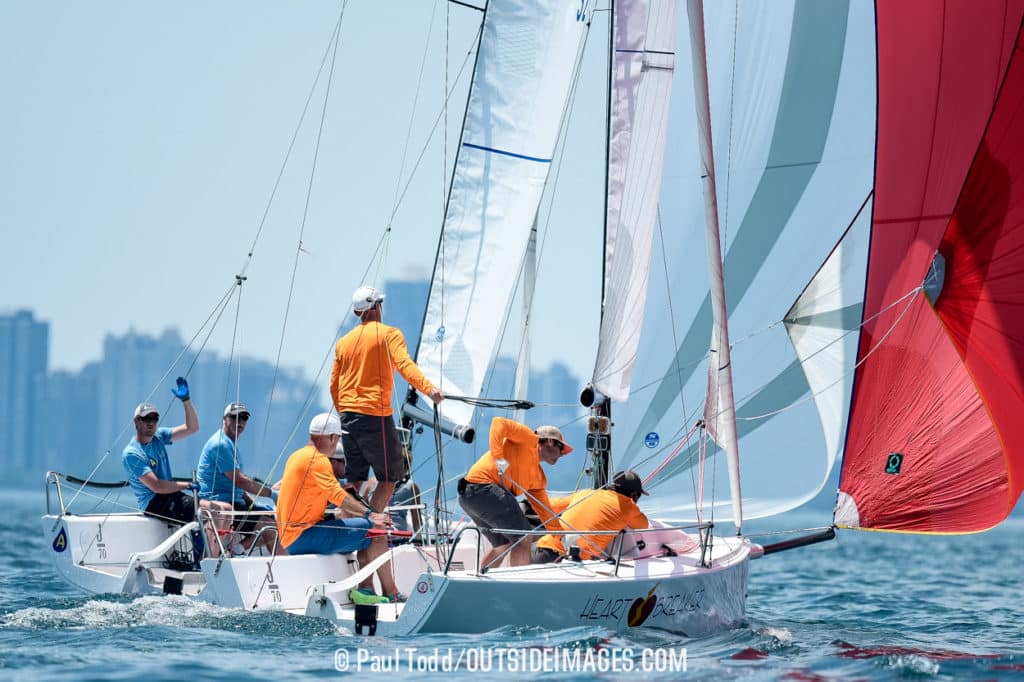
Pinwheel Avoidance
This one’s a classic: If you’re the outside boat of a group approaching the leeward mark and blindly carry on with pace, you’ll sail extra distance in bad air, carry wide around the mark, and then exit in a terrible lane. This is one of the rare times when it pays to slow down and let other boats move ahead.
To kill speed, take your spinnaker down early and steer a little extra distance. If you’re slightly advanced on the group and they barely have room, you can slow down a lot by steering hard, swerving back and forth, and swinging wide to slow your boat and kill time.
Once you’ve slowed, let the pinwheel unfold, and watch as the boats swinging around the outside become pinned and stuck in bad air. These boats had room on you, but because they are now pinned wide from the mark, they can no longer make a tight rounding and close you out.
When you can round the mark tightly without fouling those boats (because you don’t have room), sail toward the mark, ideally reaching a little bit before rounding so you have speed. You will now be on the inside track going upwind, no doubt passing a boat or two. More important, you’re setting yourself up on the inside track for a nice beat.
One cautionary note: When slowing down and waiting for your opportunity to round inside, there might be boats coming up from behind with no room who want to speed into the gap you’re shooting for. They might not slow down and wait their turn, so be sure to communicate to them that they have no rights, thus saving yourself the drama of an ugly foul and big pileup.
Overstand Recovery
Overstanding a mark is a big no-no, but we still end up doing it from time to time. The key to recovery is to start hauling butt, getting to the mark as quickly as possible. Upwind, you need to put the bow down, but in medium and heavy air, cracking off causes too much heel, so depower the rig — traveler down, backstay on, hike hard, and scoot back about a foot on the rail. The goal is to reduce helm and let it rip. Always keep a little money in the bank by sailing a touch high of the mark, just in case you get headed or a boat tacks on you. Constantly gauge your bearing to the mark by comparing it to the land behind, especially if you’re sailing in current. The worst situation is to have to tack again.
Downwind, if the lane is clear, sail high and fast toward the leeward mark. If sailing higher puts you in the dirty air from boats ahead, sail low to keep your air clear as long as possible, then heat it up late near the mark. With symmetric spinnakers, ease the pole forward and lower the topping lift, tighten the foreguy so the pole is stable, trim your main in, and hike hard to keep the boat flat. With an asymmetric spinnaker, head up, trim all sails to your new angle, and hike. When reaching, remember the vang is your throttle: on for more power and off to reduce power. Don’t let the boat heel or you’ll go sideways.
Ducking another boat
The goal when ducking another boat is to minimize loss, and if done well, possibly even pass them on the next crossing. To duck well, generate extra speed by bearing off and then taking advantage of the small lift as you cross close to the other boat’s transom. It all hinges upon making as small a course change as possible.
If it’s going to be a big duck, bear away early to set up a small turn as you are ducking. When bearing away, ease the main and jib, and hike hard to generate speed. If it’s breezy, ease the vang. Again, the goal is to bear away early, sail straight, tight reaching, for a few seconds to build speed, then head up as you approach the other boat’s stern, avoiding a big turn. As you cross behind with speed, you can smoothly return to closehauled trim.
Since you are going faster than upwind sailing speed during and after the duck, and you get a small lift from the other boat’s sails, you can burn some of that speed by pinching slightly after heading up, giving you a little more gain to windward. This will last for only a few seconds. Make the front of the jib bubble just a touch. As the boat slows, bear away to a normal angle and speed. If you do this well, when ducking on port tack, you might be able to get a piece of the boat next time you come together with starboard-tack advantage. This is especially powerful at the top of the course a few lengths under starboard tack-layline.
What if it appears the other boat will leebow you and you want to continue? If you’re in a lightweight boat with good maneuverability, try a late duck, which will keep from giving away your intentions and possibly freeze them. The rules prevent them from tacking too close, so when you duck at the last minute, hail “Don’t tack!” This might freeze the starboard tacker enough to give you a bow-out position after the meeting.
On heavier and bigger boats, bear away early and generate as much speed as possible. If they tack to leebow and you have tons of speed, you can head up firmly and smoothly, gliding above closehauled for a while and creating a lateral gap. Your momentum will carry you to weather of them, with enough of a gap to hold your lane.









